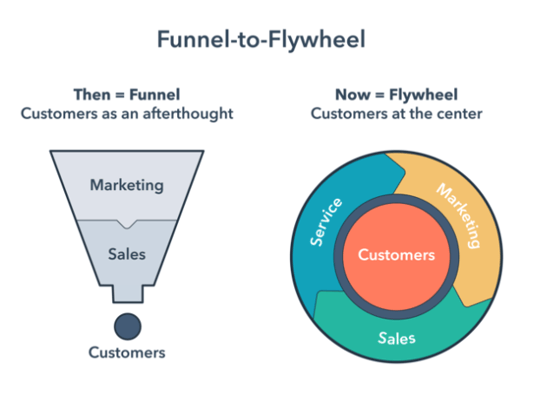
First Published: 10 July, 2019
If you've been working in marketing long enough, chances are you’ll have heard of funnels. The purchasing funnel has been at the core of modern marketing theory ever since E. K. Strong, Jr. first published it in The Psychology of Selling and Advertising back in 1925. From then on, marketers and companies all around the world have structured their business strategies around the funnel — and it's worked.
But, with the massive shift in consumer behaviours online thanks to the rise of the new information age, the funnel has begun to fail us as marketers. Today, word-of-mouth and customer referrals have become the single-largest influence on the purchasing process, which means the funnel we’ve trusted for close to 100 years has one major flaw: It views customers as an afterthought, not a driving force.
This is because funnels produce customers, but don’t consider how those customers can help you and your company grow. In a funnel, customers become the outcome, the end of the journey. All of the time and energy spent sending them down the funnel is lost as soon as they hit the end of it. So it would make sense to put customers at the centre of all that you do and use this momentum to convert this energy into even more customers. That’s where the flywheel comes into play.

The idea of a flywheel was pioneered by James Watt in the 1700s as a highly efficient way to store and regulate rotational energy in steam engines. In essence, a flywheel is a wheel in a machine that’s used to manage and increase the momentum of the operation - like wheels on a car. James engineered the flywheel, but in 2018 HubSpot engineered the flywheel theory into marketing and forever changed how we view funnels in modern marketing today.
Take a step back and imagine your business as a machine, the flywheel is the key tool for growing it. In the context of marketing, flywheels use the momentum of your happy customers and all of the energy you’ve spent getting them there to drive even more referrals and repeat sales to your business.
There are three factors that influence the speed of your flywheel:
It’s all too easy for marketers to fall into the trap of thinking about customer acquisition solely in terms of funnels. A marketing funnel assumes that there is an unlimited number of potential customers out there, and tends to focus on the never-ending chase for new customers.
This is unsustainable in the long run because it only looks at one part of the picture. By contrast, flywheels are designed to attract new customers through positive network effects of happy clients, which feeds into the marketing funnel.
With the flywheel, you use the momentum of your happy customers to drive referrals and repeat sales. Basically, to keep your business spinning.
In many ways, marketing funnels and flywheels can be compared to the flow of water. Think of the top of the funnel as a mountain or stream. The ocean represents your paying customers.
As the water falls from the sky and flows towards the sea, this is akin to your customers moving through their buying journey. Traditional marketing funnels focus on finding water at the top of the mountain and following it all the way out to sea, with the aim of bottling their share along the way.
By contrast, our flywheel is focused on the ocean of existing customers - creating evaporation (positive feedback and referrals) that leads to rain (awareness from new audiences), feeding the top of the funnel and creating a sustainable, scalable source of new clients.
Word of mouth is the most powerful form of advertising, which is why at Paintvine, we chose to design our marketing machine around the delight of raving fans.
As New Zealand’s leading creative events company, every week, we host fun paint and wine classes at local bars in over 14 locations across 8 cities in NZ. Our guests are welcomed with a complimentary drink on arrival, and soon thereafter the real enjoyment begins.
Whilst this started as a fun idea for an entertainment business, Paintvine has taken on a life of its own over the last 2 years and morphed into a prime example of how implementing a flywheel marketing strategy can be sustainable and scalable at the same time.
Behind the scenes, we focused our marketing efforts on engineering a marketing machine that is designed to grow naturally and organically attract new customers to Paintvine with minimal friction. More specifically, we created a lightning fast flywheel that attracts new customers through positive word of mouth and is amplified through social proof. This, combined with a laser focus on customer satisfaction (measured through the net promoter score) has helped us to nurture our existing customers into becoming loyal brand advocates for Paintvine.

Our flywheel has happy customers at its core:
1. We start by hosting incredible events that our guests love. At these events, we take photos which are shared on social media for our customers to enjoy later.
2. This feeds into growing evangelism for our brand and business, which happens through referrals and social shares. This grows our audience for digital marketing activities.
3. We amplify this evangelism through remarketing and conversion optimization to leverage the delight of happy customers and sell tickets to our events.
4. Which provides us with more money to invest in hosting amazing events that our customers love.
By setting out our marketing activities in this cyclical manner, we are able to narrow our focus and pay attention to what needs improving at each stage of the customer journey. As a result, our flywheel spins faster and grows larger at every stage that we invest in, allowing us to reduce friction that feeds further expansion.
Here’s a breakdown of what matters at each stage of our flywheel:
Host amazing events
We invest heavily in our artists by providing them with thorough training to ensure that no matter where in New Zealand you go, the experience is fantastic. All materials that are supplied (such as canvases, aprons and paint) are high quality and made to last.
The success of our events is measured by the net promoter score (discovered with a simple questionnaire using the Delighted app), which we use to keep on the pulse of what’s happening in each location. This way, if anything goes wrong, we can easily find out which artist, location or venue might be causing the issues. We can therefore quickly resolve issues with minimal disruption to our flywheel.
Amplify customer evangelism
After the event, we upload photos that attendees can share on their social feeds and tag friends in. It is at this point that we use Delighted to survey customer satisfaction and ask for reviews. A pivotal part in generating ever-green reviews that fuel the flywheel to spin faster.
By automating this traditionally labour intensive job, we have been able to collect hundreds of glowing reviews each and every week. This social proof and customer engagement feed the next component of our flywheel to…
Generate truckloads of awareness
Alongside the organic reach that our website receives through SEO and marketing activities, we also reach new customers by targeting lookalike audiences on Facebook and YouTube. To capture a wider audience, we do a lot of work with social media influencers.
Once people reach our website, this is where the Privy and Fomo apps come in handy:
We offer visitors the chance to win a free ticket to our next event by using Privy to capture email addresses and help to grow our mailing list for remarketing and our regular weekly mailouts.
Fomo is a social proof app that creates a sense of urgency and desire to buy straight away. Ever noticed those small popup boxes at the bottom left-hand corner of websites that say something like ‘Johnny from Hamilton just purchased a razor’ or ‘39 people are looking at this event right now’? That’s Fomo, creating FOMO.
If potential customers leave our site without buying, we then use remarketing through Google and Facebook advertising to re-engage them and draw visitors back to our website.
Clip the ticket
Once back onto our website, either through dynamic retargeting ads or through organic urgency to book we sell tickets. This closes the loop in our flywheel, we make money from ticket sales, and this gives us the resources we need to invest in host amazing events throughout New Zealand and beyond.
Paintvine has achieved phenomenal growth in such a short period of time by focusing our marketing and service efforts on around our flywheel, creating an effective marketing engine that reduces reducing friction at each stage for customers.
If you’re thinking about implementing this concept in your role or business, the best place to start is by looking at where your flywheel cycle is broken. Dissect it and pull it apart, be brutal. What are your customers saying about you? Have you got a simple metric to measure success in your business? Do you have the right apps and integrations in place to automate any repetitive aspects of the customer journey? What can you do to at each stage to convert your customer into a happy advocate?
For more info on Paintvine, check us out here. If you’d like more info on how you can implement a flywheel into your business, get in touch with me at a Hypergiant.

Contact us if you have any suggestions on resources you would like to see more of, or if you have something you think would benefit our members.
Get in TouchSign up to receive updates on events, training and more from the MA.
